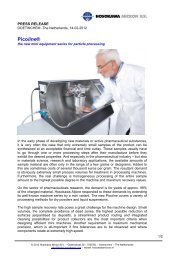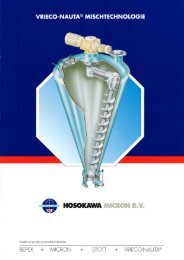Download - Hosokawa Micron BV
Download - Hosokawa Micron BV
Download - Hosokawa Micron BV
Create successful ePaper yourself
Turn your PDF publications into a flip-book with our unique Google optimized e-Paper software.
Agglomaster<br />
BATCH AGGLOMERATION<br />
There is a great demand for spray drying and granulation technologies that can reduce the process<br />
steps, give specific product properties and save energy. The following describes the direct spray<br />
drying/granulation method using the fluidized bed granulator (Agglomaster AGM-SD), which directly<br />
produces spherically shaped granules with high bulk density from liquid materials.<br />
Operating principle of the Agglomaster, AGM-SD<br />
During start-up, the fluidising air temperature is set. Once this temperature has stabilised, liquid is<br />
atomised via the bottom spray nozzles into the fluidised bed that, under certain application conditions,<br />
could be empty. The following process steps can be distinguished now:<br />
• The liquid droplets that are initially fed by spraying into the fluidbed evaporate instantaneously,<br />
and all solid material solidifies to become fine particles of a few microns. The fluidbed area is now<br />
used as spouting bed. This step can be recognised as spray drying step.<br />
• After a certain length of time, a significant amount of fine particles are formed and particle<br />
growth in the spray zone starts by particle-particle agglomeration and/or by layering agglomeration,<br />
depending on process conditions. This step is recognised as spray granulation step.<br />
• Continuation of the process results in a further growth of the particles over time and a fluidised<br />
bed of relatively large granular material is being formed. In this final stage, particle growth is<br />
mainly realised by layering agglomeration.<br />
The complete process is called Fluid Bed Spray Granulation (FBSG).<br />
Applications<br />
Key applications for Fluid Bed Spray Granulation using the<br />
Agglomaster, type SD can be found especially in:<br />
• Flavouring, artificial sweetener<br />
• natural colouring, fragrances<br />
• preservatives<br />
• extracts<br />
• vitamins<br />
• specialty chemicals<br />
• pharma formulations<br />
Fig. 4 shows an example of a liquid flavour which<br />
is spray granulated into dense agglomerates of<br />
about 400 µm particle size and bulk density of<br />
about 720 gr/ltr.<br />
Also in chemical industry interesting applications<br />
can be found, e.g. in rechargeable batteries<br />
industry (nickel, cobalt, graphite) and electronic<br />
industry (zirconia, ferrite).<br />
Conclusions<br />
Using the Agglomaster as Fluid<br />
Bed Spray Granulator instead<br />
of the conventional process of<br />
Spray Drying and Rewet<br />
Agglomeration results in the<br />
reduction of multiple unit operations<br />
and reduces the total<br />
investment cost. On top of<br />
that, operational cost will be<br />
reduced due to less thermal<br />
energy costs.<br />
Regarding the physical aspects<br />
of the product, with this technology,<br />
relatively dense granules<br />
can be formed in one single<br />
unit.<br />
Laboratory equipment as well<br />
as pilot plant equipment is<br />
available at our test station for<br />
performing application trials<br />
with your product!<br />
process air<br />
compressed air for nozzles<br />
SPRAY<br />
FLUID BED<br />
GRANULATION<br />
Figure 4<br />
central product outlet<br />
fluidised<br />
product<br />
liquid<br />
material<br />
Let your powder coating shine<br />
Powder coating is utilised more and more in the protection of, for<br />
example, decorative building sheeting and garden furniture against<br />
the environment and to increase the decorative effect the powder<br />
coating manufacturers are adding aluminium or mica to give a metallic<br />
shine to the base colour. This process is called metallic bonding.<br />
Process<br />
There are two possible routes to perform the bonding. The first<br />
one is the conventional route where mechanical energy is used to<br />
heat the mixture. The alternative route is the thermal route where<br />
a heating medium is used to heat the mixture.<br />
When using mechanical energy input, the heat input is only local<br />
(at the place of the rotor), therefore it is extremely difficult to<br />
control the temperature of the complete batch. Furthermore by<br />
rotating at high speed the powder coating and Aluminum flakes<br />
are reduced in size by grinding.<br />
In the Cyclomix the heat input is controlled by means of thermal<br />
heat input from an external jacket whilst rotating at low speeds as<br />
explained later. Only for about 10% of the total batch time the<br />
process is at high speed. This is done at the beginning of the batch<br />
in order to coat the powder coating particles with the Aluminum<br />
flakes and at the end of the batch when the powder coating is softened<br />
to bond the Aluminum flakes to the base powder coating.<br />
Because the majority of the process is at low speed we are not milling<br />
the powder coating and the pigments. This results in a flexible<br />
process where we can handle fine as well as coarse Aluminum.<br />
Cyclomix<br />
The Cyclomix is especially designed for fast, intensive and efficient<br />
mixing of powders and or liquids with some unique advantages in<br />
mixing processes where temperature control, abrasion and or<br />
cleaning is an issue.<br />
Some typical design features of the Cyclomix are:<br />
• Excellent temperature control due to the flow pattern in the<br />
Cyclomix and the jacketed vessel and cover<br />
• Flexible operation with a constant quality from 30 to 100%<br />
degree of filling<br />
• No milling effect upon powder coating particles and coarse<br />
Aluminium<br />
• Bottom outlet for full product discharge<br />
• Unique combination of high shear and impact mixing<br />
• All dynamic and static seals are out of the direct product zone<br />
• Heavy duty design for a long and maintenance free operation<br />
BATCH AGGLOMERATION<br />
Bonding process in the Cyclomix<br />
For the metallic bonding process we make use of the excellent<br />
temperature control of the Cyclomix by means of the jackets on<br />
vessel and cover. The temperature of the product is brought, in a<br />
controlled way, close to the Glass Transition temperature. At this<br />
temperature we increase the speed to perform the bonding and<br />
switch at the same time to cooling to prevent agglomeration of<br />
the batch.<br />
ATEX<br />
The unit has been designed for zone 22 externally and zone 20<br />
internally. There are 2 possible routes to deal with the internal<br />
zoning caused by the aluminium powder. The first one is purging<br />
with nitrogen and monitoring the oxygen content. The alternative<br />
route, chosen by <strong>Hosokawa</strong> <strong>Micron</strong> B.V. is pulling vacuum and<br />
monitor the vacuum level during the whole process.<br />
1000L Cyclomix bonder<br />
BONDING &<br />
EMBEDMENT<br />
Process flexibility Scale up and testing<br />
Flexibility in process is increasingly important nowadays.<br />
Customers do not like to make a batch larger than the quantity of<br />
product sold. The Cyclomix is the answer because it can be filled<br />
between 30 and 100% with still the same superb bonding effect.<br />
To prove our capabilities we have a number of test machines available<br />
in our test room. The smallest one is a 5 liter machine that<br />
can be used for the initial testing. For making test batches we<br />
have a 50 liter and finally to demonstrate and prove our scale-up<br />
capabilities we have a 250 and 500 liter version available.<br />
The 50 and 500 liter mixers are equipped with a data collection<br />
system. Data from these systems will be used to size the motors<br />
and the ancillary equipment.<br />
6 7




